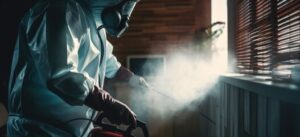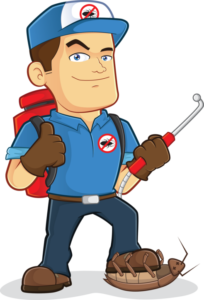St Charles Pest Control involves diminishing the damage and risks caused by vermin by protecting food, plants and property. It requires the use of a variety of tactics and the observance of all applicable State and Federal regulations.

Physical traps, screens, barriers and alteration of the environment can all be used to prevent pests from entering an area. These methods are called mechanical controls.
Preventative pest control reduces the risk of a pest infestation by keeping a property clean and limiting access to food, water and shelter. This strategy lowers the likelihood of more drastic, expensive and stressful pest-related problems. When combined with regular and effective building maintenance and inspections, preventative techniques can dramatically lower the need for reactive treatments.
Sanitation is the most basic aspect of pest prevention. Tightly sealing gaps and cracks and regularly washing all surfaces can greatly deter many pests. Frequent waste disposal and a strict separation of trash, compost, recyclables and garbage can further reduce pest-attracting variables like food scraps, rotting materials and open containers.
Physical barriers, such as screens, traps and barriers made of wire mesh, can also be effective in keeping pests out of buildings or enclosed spaces. Inspecting all incoming goods, materials and food packages for signs of pests and rodents can also be very helpful in preventing outbreaks.
Biological methods, which use natural enemies to reduce or eradicate pest populations, are usually the preferred preventive method. These can include predatory species, parasites and pathogens. They do not involve the use of chemicals and can be a great option for sensitive areas where chemical sprays are not desirable. However, biological methods take more time to work and must be supplemented with other preventive measures.
Climate is another natural force that affects pest populations, directly or indirectly. Cooler temperatures and lower humidity can slow the growth of some pests or cause them to die. Unusually hot or cold weather can also disturb normal pest-growth patterns, resulting in higher or lower pest populations than usual.
Infestation prevention is the key to minimizing both damage and costs. A thorough inspection and cleaning program for warehouses, manufacturing facilities, restaurants, hospitals and any other indoor environment is vital. The use of appropriate sealants and screens can further help to keep out pests, as well as maintaining a proper temperature, air circulation and humidity. Creating clear lines of sight along walls through the organized layout of shelving and cabinets decreases the labor of inspections while making it easier to spot pests early on.
Suppression
Pests can be destructive and dangerous to human beings. They can cause economic and aesthetic damage, and may carry disease-causing pathogens. The goal of pest control is to reduce their numbers to an acceptable level. Suppression is usually the first step in a pest management plan. It is followed by prevention and eradication.
Pest suppression strategies can include trapping, scouting and monitoring for insect, insect-like, mollusk, vertebrate and weed pests; monitoring soil conditions; weather monitoring; and record keeping. The records provide the basis for crop rotation planning, economic threshold development and decision making. They also are the basis for establishing and implementing preventive measures.
Physical controls, including barriers, screens, fences, radiation, heat and chemicals, can prevent or destroy pests or limit their spread. Devices that attract, repel or kill pests can be used in a variety of settings and are generally the fastest means of controlling many pest species. These include baits, traps, pheromone lures, light and heat, acoustic devices and fumigation.
Natural forces affect the population growth of all organisms, including pests. Natural enemies, natural barriers (such as waterways and mountains), and the availability of food, shelter and other resources all can influence the size of a pest population.
The natural enemy of a pest is a predator or parasite that feeds on or preys upon the pest to reduce its numbers. Birds, reptiles, amphibians and mammals are important natural predators of some pests. Pathogens, which are disease-causing microorganisms, also can suppress pest populations.
When the natural enemies of a pest are limited or do not control pests, pesticides must be applied to suppress them. However, it is important to structure the applications of pesticides to exploit complementarities provided by natural agro-ecosystem processes as much as possible, in order to minimize negative spillover effects.
Some pesticides kill pests directly while others control their growth or activity. Pesticides can be inorganic or organic. Biological control agents, such as beneficial insects, mites and nematodes, also are used in some situations. However, they take time to build up to sufficient numbers and can be unpredictable. In addition, different biocontrol agents often are effective against only one or a few species of pests. For example, the predatory mite Amblysieus swirskii can feed on thrips and whiteflies, but it is ineffective against caterpillars or grubs.
Eradication
Eradication differs from suppression or containment because it seeks to eliminate a pest from a region or entire world (Food and Agriculture Organization, 2005). To be successful, eradication must involve all of the components of control: prevention, suppression, eradication, and treatment.
Prevention involves preventing the introduction of organisms that can cause plant disease into an area. This includes requiring clean tarps to be used during the movement of equipment or materials and requiring a clean environment prior to planting, as well as establishing quarantines or other barriers between infested and uninfested areas. It also requires monitoring of organisms to detect and destroy them before they cause significant economic damage.
Suppression involves maintaining the population of an organism below the level that causes economic injury (Food and Agriculture Organization, 2005). It is often combined with eradication, as it is difficult to achieve a zero population without also destroying the natural predators of a pest.
Chemical spraying can be a highly effective method of suppressing pests, but the more chemical is used, the higher the risk to human and environmental health. It is therefore essential to understand and monitor pest resistance to chemicals and to use the minimum amount necessary for a given area or situation.
Biological controls, including the release of natural enemies such as parasitoids and pathogens to kill or otherwise reduce pest populations, can be effective. However, these approaches are rarely able to achieve eradication and are usually supplemental to other control measures.
Other types of control methods may include traps, pheromones, or the destruction of breeding sites (e.g., by plows). However, this method is not suitable for all pests and the failure of one trap or device does not necessarily indicate that the eradication process will fail.
The eradication of a pest in an outdoor setting is often very difficult to achieve, especially with social insects. The odds of eradicating a social insect are 79% lower than for non-social species, because the eusociality of the target organism makes it very difficult to coordinate and control its activities. Ideally, an eradication program should be conducted after extensive research and a thorough understanding of the pest’s biology has been achieved.
Treatment
In some cases, when prevention and suppression have failed to reduce pest numbers to acceptable levels, eradication may be the desired goal. This is most common in enclosed environments, such as health care, food processing and preparation, and food storage facilities. In these situations, there is often zero tolerance for pests in terms of contamination or damage to the products and facilities. Eradication is generally more difficult to achieve than prevention and suppression, and it can be very costly. For example, the eradication of the Mediterranean fruit fly, gypsy moth, and fire ant was accomplished at great cost through massive chemical spraying programs.
In agriculture, preharvest pest control is important to reduce losses from insects and diseases that can affect yield and quality. This includes the application of cultural practices to alter the environment, the condition of the host plant or the behavior of pests, as well as the use of crop protection chemicals.
Inside homes, pests are controlled primarily through sanitation and exclusion. This includes removing food and water sources, cleaning and sealing surfaces where pests can breed or hide, and blocking access to entry points such as cracks and crevices. It also involves securing garbage and compost bins so that pests cannot access them.
Treatments used by pest control professionals include insecticides, rodenticides, nematodes, plant growth regulators and biological controls. Biological controls involve the introduction of organisms that are natural enemies or parasites of pests, such as predators and pathogens. This can often be less expensive and more effective than using chemical pesticides.
In addition, pheromones can be useful in monitoring pest populations, and artificial pheromones can be used to lure male pests away from females. This can help reduce the number of mating pests and prevent the production of offspring.
Be sure to hire a professional pest control service that is licensed and insured. Ask for an initial inspection of your property and a customized pest control plan. Look for a company with experience and expertise in your area, and a team of highly trained technicians who are knowledgeable about local pests. Be sure to discuss all treatment options with your technician, including non-chemical options. Finally, be sure to read and follow all safety precautions on the pesticide label.
